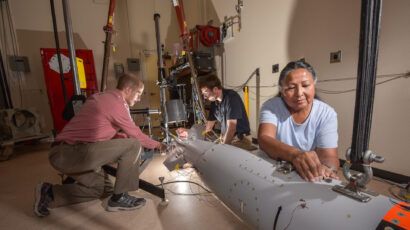Neuroethicists are not saying enough about the problem of dual-use
By Malcolm Dando | July 8, 2010
The minutes of many U.K. Ministry of Defense’s secret committees’ meetings held during the Cold War period are now available to the public in the National Archives. Thus, we know that one March day in 1959, the Chemistry Committee of the U.K.’s Advisory Council on Scientific Research and Technical Development met in London to discuss the possibilities for developing new chemical incapacitating weapons agents–including ones with neurological effects–something both the United Kingdom and its allies were trying to achieve. According to the minutes of the meeting, the technical experts were not optimistic. One of them, identified as Dr. Bowman, said the field was not particularly promising given what was known from the large amount of work done by pharmaceutical firms working on cures for mental illnesses. Following this, the minutes of the meeting state that :”…THE CHAIRMAN, however, emphasised that the Committee was looking for [an] agent which would produce, not cure, psychoses; we might succeed by modifying the curative agents…” The Chairman, therefore, held a very modern view of dual-use in which civil science could produce materials, technologies, and knowledge that might be misused later by those with hostile intent–not the usual Cold War view, in which military research produced civilian spin-offs, such as the Internet.
In regard to the question of dual-use, the advances in neuroscience have already seen application in the Russian use of some form of fentanyl, a powerful painkiller, as a novel incapacitating chemical agent to break the 2002 Moscow theater siege.
To be sure, the current concern about dual-use both recognizes this possible role of civilian institutions generally and also extends this concern specifically to substances with neurological effects. The second recommendation of the 2006 U.S. National Academies report entitled “Globalization, Biosecurity, and the Future of the Life Sciences”–often called the Lemon-Relman report–states: “Adopt a broadened awareness of threats beyond the classical ‘select agents’ and other pathogenic organisms and toxins, so as to include, for example, approaches for disrupting host homeostatic systems…” Homeostatic systems include the chemical neurotransmitters and neuromodulators that regulate the human nervous system.
Since the end of the Cold War, we also have seen the rise of a new sub-division of bioethics: neuroethics. Neuroethics is concerned with both philosophical issues about the relationship between brain and mind and practical issues about the impact of our growing ability to understand and manipulate the brain upon society. It is therefore of some interest to discover what this comparatively recent field of study has to say about the problem of dual-use.
Of course, some of the issues related to the growth of neuroscience, such as safety and rationing of new therapies, are not different from those discussed by bioethicists in other fields, but neuroethicists clearly believe that their field does raise some new issues. In this regard, it is important to note that, despite such novel aspects of neuroethics, neuroethicists see themselves as doing the same kind of work as other bioethicists. Their view is that a new technology is giving rise to problems that are beyond the capabilities of the scientists involved, and that there is therefore a need to bring other appropriate skills to bear in order to help the practitioners involved to decide what is best to do. Of course, sociologists would point out that history suggests that there might be other explanations for what the ethicists are doing–such as facilitating the introduction of new technologies that might not be to the benefit of everyone.
Reviewing the growing literature on neuroethics allows a certain number of conclusions to be drawn about its present characteristics. It is striking how a limited number of issues are discussed time and time again in different papers. The practical (e.g., lie detection, neuromarketing) and philosophical (e.g., personal responsibility) implications of advances in neuroimaging are clear examples of this over-concentration on a limited range of subjects. In contrast, it is very difficult to find many mentions of the problem of dual-use, let alone any detailed discussion of the problem and what might be done about it in this literature. There appear to be almost no papers that actually set out some methodology that the neuroscientist might use to get a better grasp of an ethical problem other than to in some way engage with neuroethicists, who sometimes seem intent on the facilitation of the introduction of new technologies rather than providing critical analysis using different ethical approaches.
In the hope of finding a different outcome I decided to look in more depth at the topic of cognitive enhancement through the use of medical drugs. This, again, is one of the major subjects of the neuroethical literature and is very obviously related to the problem of dual-use (as the Chairman of the U.K.’s Chemical Committee understood all too clearly in 1959). This part of the neuroethics literature is concerned with the possible enhancement of attention through the use of methylphenidate (medical use: ADHD), alertness through the use of modafinil (medical use: narcolepsy), memory through the use of various drugs being developed in the search for a means of dealing with Alzheimer’s Disease, and mood though the use of selective serotonin reuptake inhibitors. Given that these drugs have proper medical uses, the question is whether people who are already well could benefit by using such medication.
A somewhat different question arises in regard to trying to help people suffering from Post Traumatic Stress Disorder (PTSD) in which recurring memories of traumatic events might be reduced by the use of propranolol. Much is known about the role of noradrenaline in memory formation and consolidation and the drug can interfere with these processes. In a rare exception to the general rule, some neuroethicists have realised that there might be a downside to the use of such medication for “therapeutic forgetting.” As senior researcher Kathinka Evers noted, if the drug could help soldiers “forget what they have been subject to, it also helps them forget what they have done to others.”
For the most part, however, great reservations are in order about just how effective such non-medical manipulation of the brain is at the present time even if it will eventually become possible. My guess is that many practicing scientists would be sympathetic to the view that the current discussion of cognitive enhancement is a phantom debate as they think it will be a long time before the technologies are good enough (for example, being free of side effects) to raise real social problems.
Yet, in regard to the question of dual-use the advances in neuroscience have already seen application in the Russian use of some form of fentanyl, a powerful painkiller, as a novel incapacitating chemical agent to break the 2002 Moscow theater siege. Moreover, Russia is unlikely to be the only state interested in the development of such new agents, given the changing nature of modern warfare. One can only hope that neuroethicists will begin to pay some attention to the clear and present danger that the hostile misuse of modern neuroscience could lead to the erosion of the prohibition of chemical weapons embodied in the Chemical Weapons Convention and make a valuable contribution to the discussion of this problem in the run up to the 3rd Five Year Review Conference of the convention in 2013. For example, the peaceful purpose defined in Article II.9 (d) as “Law enforcement including domestic riot control purposes” could be read to mean that ordinary domestic riot control agents are a sub-category of a larger group of chemical agents that can be used legally. On this reading, novel so-called non-lethal chemical incapacitating agents based on advances in modern civil neuroscience could be developed and used. Yet all the evidence is that use of such agents would be very difficult to distinguish from the use of lethal agents; recall that more than 120 of the hostages in the Moscow theater siege were killed by the chemical agent. Such developments by states could undermine the whole prohibition and lead to a downward spiral of misuse. Therefore, this issue of dual-use should be of great concern to neuroscientists, and particularly neuroethicists, who wish to help protect civil neuroscience from such dreadful distortion of its intended purpose.
Together, we make the world safer.
The Bulletin elevates expert voices above the noise. But as an independent nonprofit organization, our operations depend on the support of readers like you. Help us continue to deliver quality journalism that holds leaders accountable. Your support of our work at any level is important. In return, we promise our coverage will be understandable, influential, vigilant, solution-oriented, and fair-minded. Together we can make a difference.
Topics: Biosecurity, Columnists















